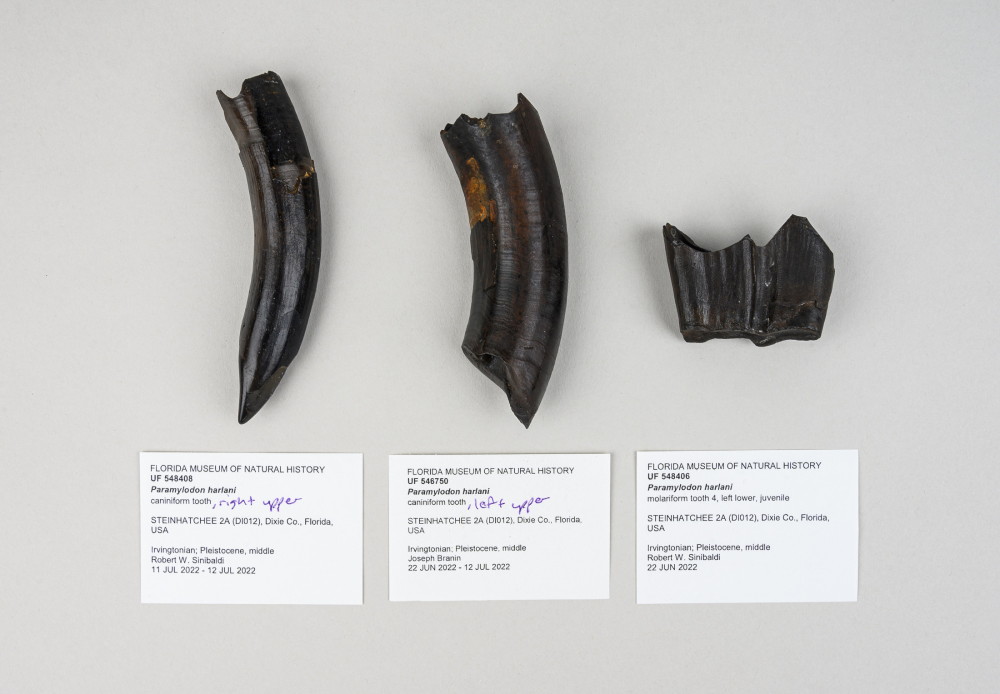Fossil collectors submerged in the murky Steinhatchee River in Florida struck unlikely gold in 2022 when they discovered some old horse teeth. They continued their search in an expedition likened to “diving in coffee,” and were rewarded with a hoof core and a tapir skull. “We knew we had an important site,” said Robert Sinibaldi in a release, “but we didn’t know how important.”
ADVERTISEMENT GO AD FREE
The region of the river in which Sinibaldi and fellow collector Joseph Branin were hunting was once a sinkhole that filled in with sediment. Five hundred thousand years later, it’s belching up remarkably well-preserved fossils, telling the tales of horses, sloths, tapirs, and armadillos that took an unfortunate tumble half a million years ago.
The river is only now revealing these fossils because its path has moved over millennia. Once flowing somewhere else, its waters are now coursing over and eroding the former pit, effectively rinsing off the fossils. Pretty handy for the terrestrial fossil hunter venturing optimistically – if not a little blindly – into waters that contain so many tannins they look like coffee.
Sinibaldi and Branin shared their finds with the Florida Museum of Natural History, where it was revealed exactly why these fossil finds are so remarkable. They originate from a period in geological time about which we know very little, with only one other known site in Florida yielding such fossils in the past. A rare find for the state, as well as the rest of the country.

Hundreds of horse fossils have been recovered from the Steinhatchee River site, indicating the area was once an open, grassy area.
Image credit: Florida Museum photo by Kristen Grace
“The fossil record everywhere, not just in Florida, is lacking the interval that the site is from – the middle Irvingtonian North American land mammal age,” said Rachel Narducci, vertebrate paleontology collections manager at the Florida Museum and coauthor of a new study of the site.
The study cataloged 552 fossils from the site, now known as the Steinhatchee River 2A (STR 2A) locality. It found that around 75 percent of those retrieved belonged to an unidentified species of horse, which tells us the environment was likely fairly open rather than being heavily wooded, as otherwise we would’ve found remains of things like mastodons and deer.
There were also samples of extinct megafauna in the mix. They included Holmesina and Dasypus, large relatives of armadillos, and the ground sloths Megalonyx and Paramylodon.
ADVERTISEMENT GO AD FREE
Holmesina is a particularly interesting find from the middle Irvingtonian as during this time they underwent a significant change in size, blooming from around 68 kilograms (150 pounds) to 215 kilograms (475 pounds). These mid-Irvingtonian samples give us a look at the intermediate changes that occurred before they grew so drastically in size that they became a new species.

Giant ground sloths are a regular feature in Florida paleontology, and the Steinhatchee site is no exception.
Image credit: Florida Museum photo by Kristen Grace
“It’s essentially the same animal, but through time it got so much bigger and the bones changed enough that researchers published it as a different species,” said Narducci. “This gave us more clues into the fact that the anatomy kind of trailed behind the size increase. So, they got bigger before the shape of their bones changed.”
Another find of note was a remarkable tapir skull with traits that don’t seem to add up. More of its skeleton is needed before firm conclusions can be made, but it could be that it’s a new-to-science species, or – as Richard Hulbert, lead author of the paper and retired Florida Museum vertebrate paleontology collections manager put it – “It always could just be that you picked up the oddball individual of the population.”
The search will continue at the STR 2A locality, albeit it likely quite slowly. Diving into coffee isn’t the easiest way to find fossils, but clearly, it does turn up some good’uns.
ADVERTISEMENT GO AD FREE
The study is published in the journal Fossil Studies.
Source Link: Collectors “Diving In Coffee” Discover Rare 500,000-Year-Old Underwater Fossil Bed